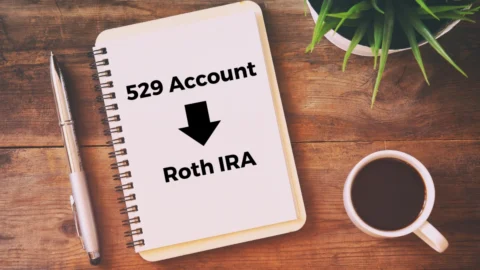How To Manage Capital Gains Distributions
A Guide for Navigating the Tax Pitfalls Associated with Capital Gains Distributions
Capital gains distributions are a common occurrence for investors, especially those who invest in mutual funds. These distributions are a portion of the fund’s profits that are paid out to shareholders. While it may seem like a good thing to receive a distribution, it can also have tax implications and affect your overall investment strategy. In this article, we will discuss how to manage capital gains distributions and minimize any negative impact on your investments.
It is important to note that this article is only applicable to taxable brokerage accounts. Retirement accounts like IRAs or 401(k)s are tax-deferred. This means that capital gains distributions will not count as realized gains in the period that they are received, and can be safely ignored.
Understanding Capital Gains Distributions
Before we dive into managing capital gains distributions, it’s important to understand what they are. When a mutual fund sells securities that have increased in value, it realizes a capital gain.
By law, mutual funds are required to distribute these gains to shareholders at least once a year. The distribution is considered taxable income and should be reported on one’s tax return for the year in which it was received. This means that even if the distribution is reinvested, taxes will still be owed.
It is worth noting that these distributions are separate from the fund’s overall profit, which is calculated based on the performance of the fund’s investments. Capital gains distributions are simply the result of the fund’s buying and selling activity, and they can have tax implications for shareholders.
Managing Capital Gains Distributions
Capital gains distributions can be a hassle to manage, but they don’t have to be. With a little bit of planning, the impact on your taxes can be minimized. Here are some tips for managing capital gains distributions.
Invest in Tax-Efficient Funds
The best way to avoid the capital gains distributions associated with mutual funds is to invest in exchange-traded-funds (ETFs) instead. ETFs are structured in a way that allows for more efficient tax management.
Unlike mutual funds, which are required to distribute capital gains to shareholders annually, ETFs typically have a more tax-efficient structure. This is because ETFs use an “in-kind” share creation and redemption process, which allows them to avoid triggering taxable events when underlying stocks are bought or sold. As a result, ETF investors may have fewer capital gains distributions and potentially lower tax liabilities.
Additionally, ETFs often have lower portfolio turnover compared to mutual funds. Portfolio turnover refers to the frequency with which securities are bought and sold within a fund. A lower turnover rate means fewer opportunities for capital gains to be generated, further reducing the likelihood of capital gains distributions.
However, it’s important to note that not all ETFs are created equal when it comes to tax efficiency. Some ETFs may still generate capital gains distributions, especially if they track indexes that have a high turnover rate or are actively managed. Therefore, it’s essential to research and consider the specific ETF’s tax management strategy before investing.
In some cases, it can make sense to sell out of a mutual fund position to invest in a more tax-efficient alternative. However, if the mutual fund is holding a significant gain or has no reasonable ETF substitute, the best option might be to keep the position in one’s portfolio.
Check The Funds’ Distribution Schedule
The first step in managing capital gains distributions is to check the funds’ distribution schedule. This will provide an idea of when to expect distributions and how much they may be. This information can usually be found on the fund’s website or by contacting the fund directly. By knowing when distributions will occur, an investor can plan accordingly and potentially avoid any unexpected tax bills.
Consider Tax-Loss Harvesting
Tax-loss harvesting is a strategy that involves selling securities at a loss to offset capital gains. This can be a useful tool for managing capital gains distributions.
For example, if an investor has a mutual fund that has realized a large capital gain, they can sell another fund at a loss to offset the gain. This can help reduce one’s overall tax liability for the year.
To learn more about tax-loss harvesting, please refer to our article on the topic.
Tax-Gains Harvesting
Tax-gains harvesting can be a strategic method for diversifying out of mutual fund positions while minimizing the impact on one’s tax bracket. By selectively selling mutual funds that have significant gains, an individual can rebalance their portfolio and reduce the risk associated with holding too much of their investments in a tax-inefficient fund.
One benefit of capital gain harvesting is that it allows an investor to realize gains on their high-performing funds without necessarily triggering a higher tax bracket. By selling only enough shares to stay within their current capital gains tax bracket, one can realize the gains while still maintaining a favorable tax rate.
Additionally, tax-gains harvesting can help manage one’s capital gains distributions. By selling funds with expected capital gains distributions, an investor can reduce the amount of capital gains that appear on their tax return each year. This can be particularly useful for funds that consistently distribute capital gains, as it can help reduce the overall tax liability in perpetuity.
It’s important to note that tax-gains harvesting should be approached with careful consideration and in consultation with a financial advisor or tax professional. An expert can evaluate your specific situation and determine the best strategy for managing capital gains distributions while maintaining a diversified portfolio.
Reinvest Distributions Wisely
When a capital gains distribution is received, an individual has the option to reinvest it or receive it as cash. If minimizing the tax impact is a priority, it may be wise to reinvest the distribution in a tax-efficient investment or tax-advantaged account, such as an IRA or 401(k). This will allow an investor to defer paying taxes on the distribution until the funds are withdrawn in retirement. Additionally, reinvesting the distribution can help the investments continue to grow.
FAQs
Below we have provided some frequently asked questions regarding Capital Gains Distributions.
What are the implications of capital gains distributions for investors in tax-deferred accounts versus taxable accounts?
For investors with holdings in both tax-deferred accounts, such as IRAs or 401(k)s, and taxable accounts, the impact of capital gains distributions differs markedly. In a tax-deferred account, capital gains distributions are not immediately taxable. Instead, they are reinvested, and the entire amount will be taxed as ordinary income upon withdrawal, based on the account’s tax rules.
In contrast, capital gains distributions in taxable accounts are subject to tax in the year they are distributed, potentially increasing the tax burden for the investor in that year. The management strategies for these distributions, therefore, need to be tailored to the type of account to optimize tax efficiency.
How can investors use specific lots of shares when selling to minimize taxes on capital gains?
Using specific lots of shares is a tactic that can be used when selling investments to manage capital gains taxes more effectively. By selecting specific shares to sell, based on the purchase date and cost basis, investors can target shares that will result in a lower tax liability.
For example, selling shares that have been held for over a year may qualify for long-term capital gains tax rates, which are typically lower than short-term rates. Alternatively, an investor might choose to sell shares with a higher cost basis to minimize the taxable gain or even sell shares at a loss to offset other gains, a practice known as tax-loss harvesting. This strategy requires meticulous record-keeping and planning, as investors must specify which shares are being sold at the time of the transaction and must be able to provide documentation to support their choice if questioned by tax authorities.
Conclusion
While capital gains distributions may be unavoidable in some circumstances, it is important to be prepared in order to avoid a surprise increase to your tax liability. Taking the time to effectively plan and consider the various strategies outlined in this article can lay a strong foundation for managing these distributions.
However, it is crucial to recognize that each individual’s financial situation is unique and complex, thus necessitating the need for a personalized approach. What may prove successful for one person might not be as effective for another due to varying factors such as income levels, investment portfolios, and long-term financial goals.
Therefore, seeking the guidance of a qualified financial professional becomes imperative to ensure educated and well-informed decisions are made regarding capital gain distributions. The expertise and knowledge provided can assist in navigating the intricacies of this process and help optimize tax efficiency, ultimately contributing to a more secure financial future.
Need Some Help?
If you’d like some help from one of our CPAs or CERTIFIED FINANCIAL PLANNER (CFP®) advisors regarding this strategy and how it applies to you, the Rhame & Gorrell Wealth Management team is here to help.
Our experienced Wealth Managers facilitate our entire suite of services including financial planning, investment management, tax optimization, estate planning, and more to our valued clients.
Feel free to contact us at (832) 789-1100, [email protected], or click the button below to schedule your complimentary consultation today.
IMPORTANT DISCLOSURES:
Corporate benefits may change at any point in time. Be sure to consult with human resources and review Summary Plan Description(s) before implementing any strategy discussed herein.Rhame & Gorrell Wealth Management, LLC (“RGWM”) is an SEC registered investment adviser with its principal place of business in the State of Texas. Registration as an investment adviser is not an endorsement by securities regulators and does not imply that RGWM has attained a certain level of skill, training, or ability. This material has been prepared for informational purposes only, and is not intended to provide, and should not be relied on for, tax, legal or accounting advice. You should consult your own CPA or tax professional before engaging in any transaction. The effectiveness of any of the strategies described will depend on your individual situation and should not be construed as personalized investment advice. Past performance may not be indicative of future results and does not guarantee future positive returns.
For additional information about RGWM, including fees and services, send for our Firm Disclosure Brochures as set forth on Form ADV Part 2A and Part 3 by contacting the Firm directly. You can also access our Firm Brochures at www.adviserinfo.sec.gov. Please read the disclosure brochures carefully before you invest or send money.













